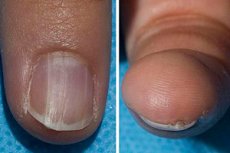Benign nail condition linked to rare cancer syndrome
Sist anmeldt: 14.06.2024

Alt iLive-innhold blir gjennomgått med medisin eller faktisk kontrollert for å sikre så mye faktuell nøyaktighet som mulig.
Vi har strenge retningslinjer for innkjøp og kun kobling til anerkjente medieområder, akademiske forskningsinstitusjoner og, når det er mulig, medisinsk peer-evaluerte studier. Merk at tallene i parenteser ([1], [2], etc.) er klikkbare koblinger til disse studiene.
Hvis du føler at noe av innholdet vårt er unøyaktig, utdatert eller ellers tvilsomt, velg det og trykk Ctrl + Enter.

Scientists at the National Institutes of Health (NIH) have discovered that having a benign nail abnormality can lead to a diagnosis of a rare inherited disorder that increases the risk of developing cancers of the skin, eyes, kidneys, and tissues lining the chest and abdomen (such as the mesothelium).
The disorder, known as BAP1 tumor predisposition syndrome, is caused by mutations in the BAP1 gene, which normally functions as a tumor suppressor, among other functions.
The study is published in the JAMA journal Dermatology and were presented at the annual meeting of the Society for Investigative Dermatology (SID 2024), which was held in Dallas from May 15 to 18.
The researchers made the discovery by chance while studying participants enrolled in a screening study for BAP1 variants at the NIH Clinical Center. As part of the study, dermatology screening was performed at enrollment and annually for participants aged 2 years and older. The current study included 47 people with BAP1 tumor predisposition syndrome from 35 families.
"When asked about his nail health during his baseline genetic evaluation, the patient remarked that he had noticed subtle changes in his nails," said study co-author and genetic counselor Alexandra Lebensohn, MS, of the NIH National Cancer Institute (NCI). "His comment prompted us to systematically evaluate other participants for nail changes and identify this new observation."
Biopsies of the nail and underlying nail bed in several participants confirmed the researchers' suspicions of a benign tumor abnormality known as onychopapilloma. The condition causes a colored band (usually white or red) along the length of the nail, thickening of the nail beneath the discoloration, and thickening at the end of the nail. It usually affects only one nail.
However, among study participants with a known BAP1 tumor predisposition syndrome aged 30 years or older, 88% had onychopapillomas affecting multiple nails. The researchers suggest that nail screening may be especially valuable for patients with a personal or family history of melanoma or other potential BAP1-associated malignancies.
"This observation is rare in the general population, and we believe that the presence of nail changes consistent with onychopapillomas on multiple nails should raise suspicion for BAP1 tumor predisposition syndrome," said Edward Cowan, MD, chief of dermatology consultation services at the NIH's National Institute of Arthritis and Musculoskeletal and Skin Diseases (NIAMS).
"This discovery is an excellent example of how interdisciplinary teams and natural history studies can uncover new knowledge about rare diseases," said Raffit Hassan, MD, co-author of the study and principal investigator of the clinical protocol under which these patients were enrolled.
